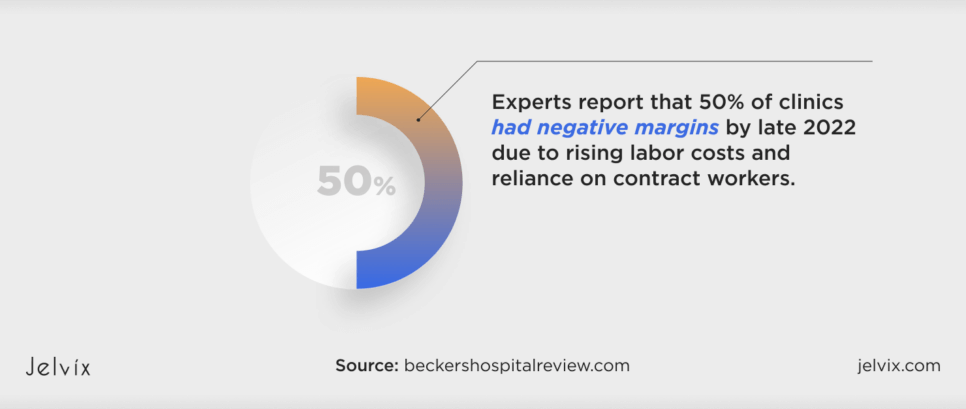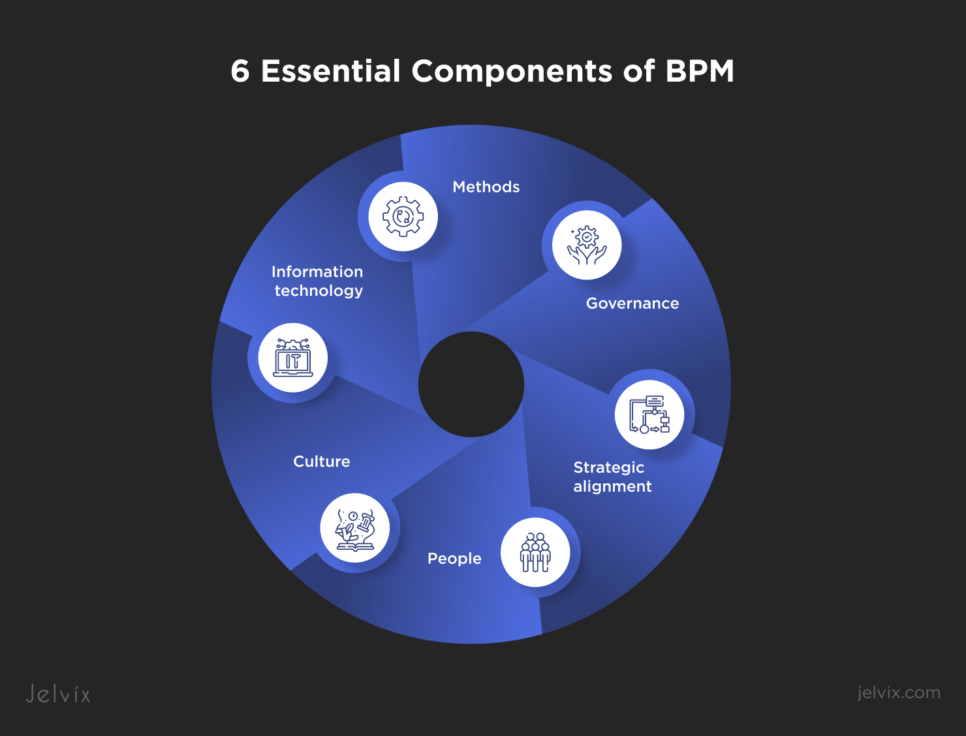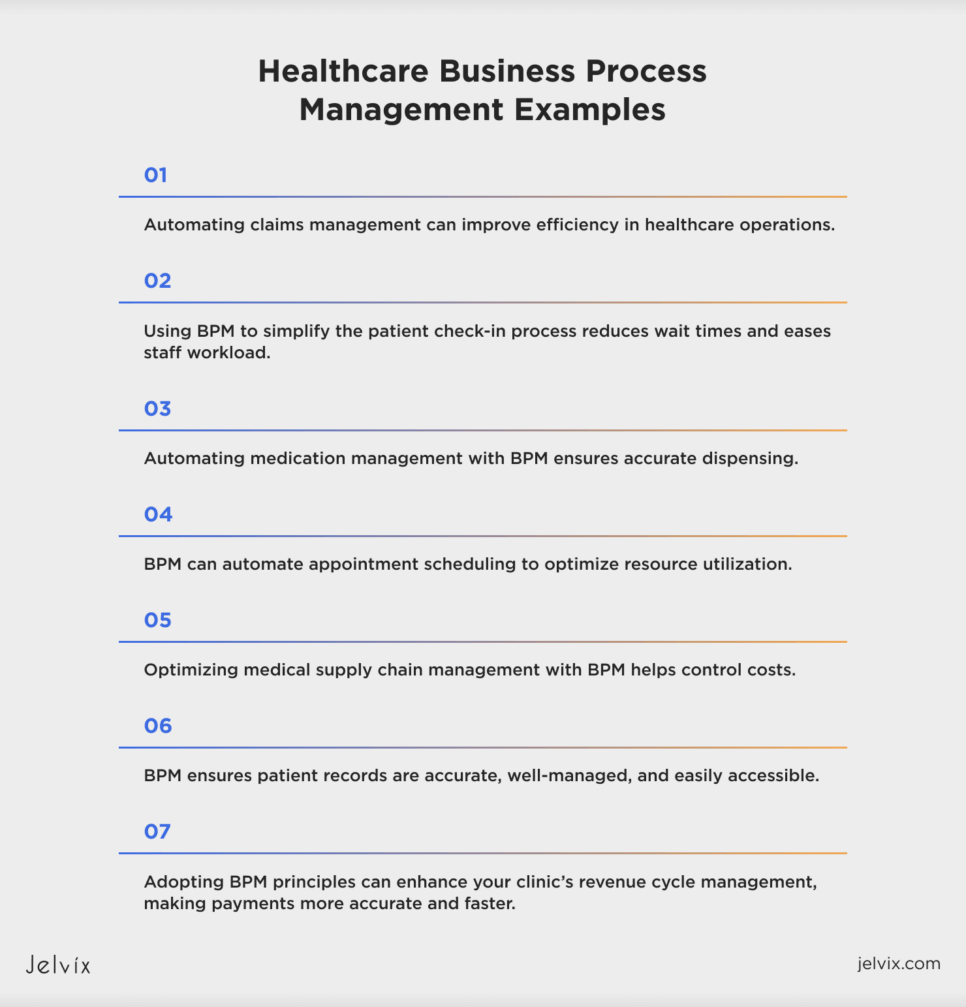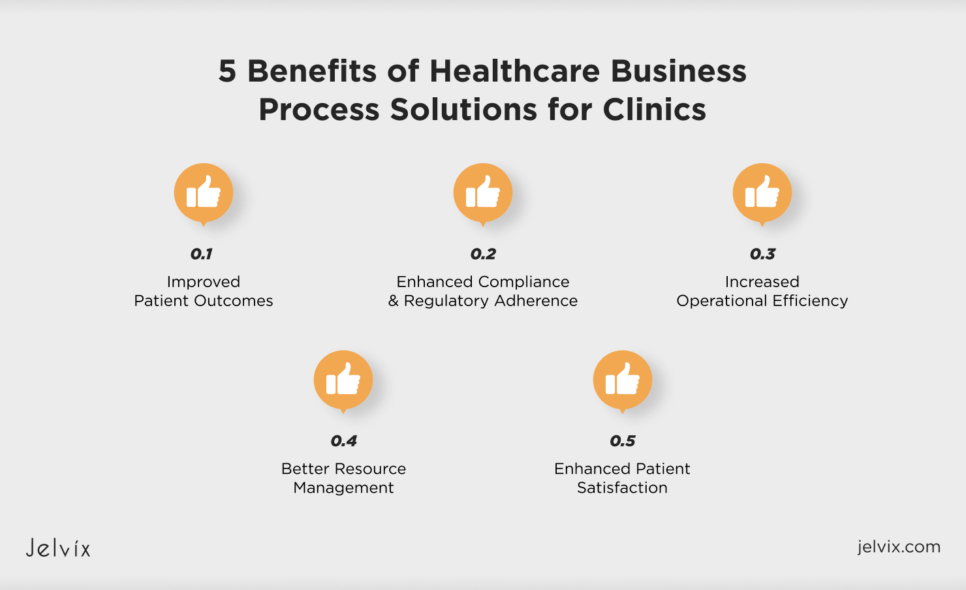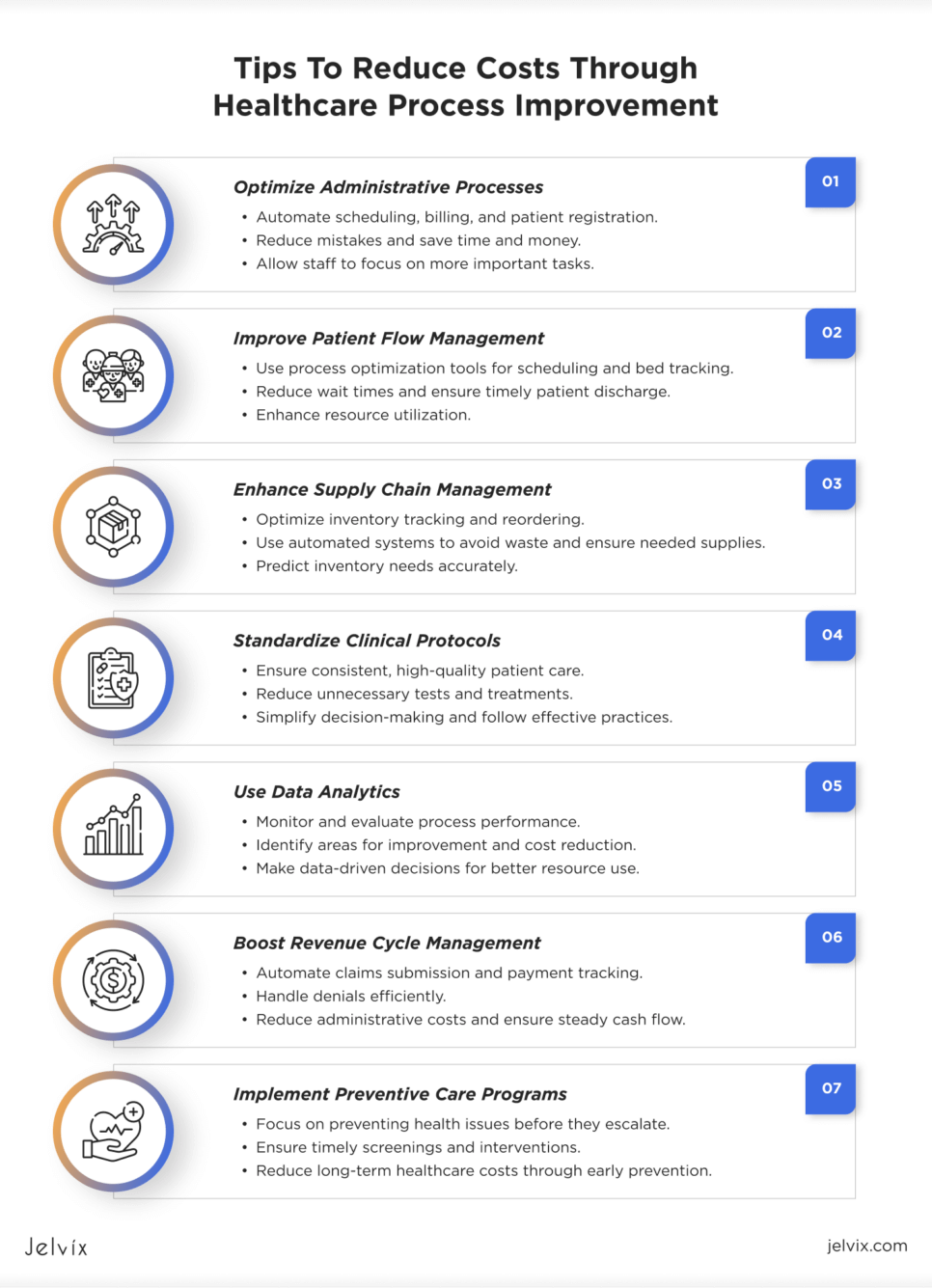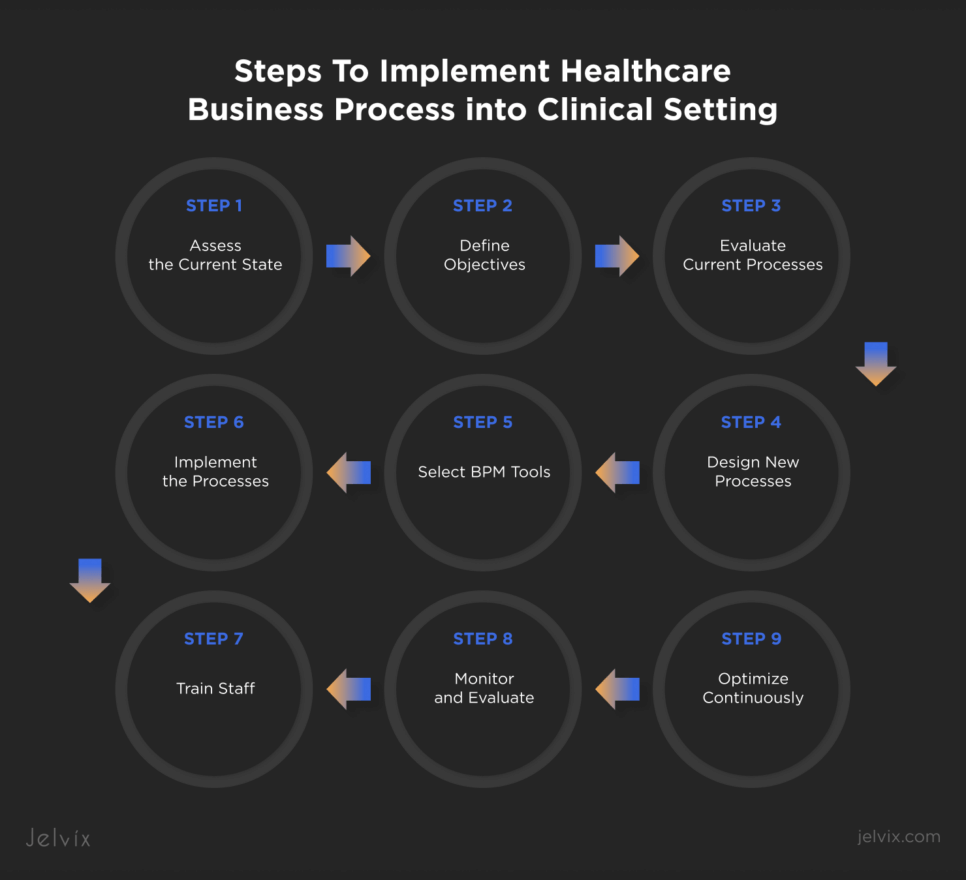Healthcare has always been a complex industry, mainly driven by manual effort. Despite the growing amount of medical data, many clinics still rely on manual work putting their operations under threat.
Experts say that 50% of clinics experienced negative margins by the end of 2022 due to a rise in labor costs and increased use of contract workers to fill staffing gaps. What’s more, healthcare costs keep increasing, highlighting the need to adopt new and efficient business solutions.
If you seek a smart approach to improve business operations at your hospital, read this article. You’ll find out how to reduce operational costs with the help of business process management, what benefits it can deliver, and how to implement it into your settings efficiently.
What Is BMP in Healthcare and Why Is It Important for Clinics?
Business process management is a method to make workflows more efficient and smooth. It involves looking at how things are done, finding better ways to do them, putting these new ways into practice, and constantly checking and improving them.
BPM includes seven key components:
- Strategic alignment: making sure all business processes line up with the company’s overall goals and objectives;
- Governance: setting rules and policies to guide process management and ensuring to follow regulations;
- Methods: using the best practices and standardized methods to analyze and improve business processes;
- Information technology: using tools to automate and optimize processes to make them more efficient;
- People: getting staff and stakeholders involved in process management activities and ensuring they’re well-trained;
- Culture: creating an environment where staff is encouraged to find and suggest process improvements, supporting a culture of continuous improvement.
In healthcare, BPM helps make administrative and clinical processes better to improve patient care and make operations more efficient. This often involves healthcare software development to support the BPM approach.
Healthcare Business Process Management Examples
To better understand how this methodology works, it’s worth examining BPM examples that range from claim management to controlling revenue cycles.
Claims Management
Automating the management of claims can improve how efficiently things run in healthcare. BPM tools help make the submission process better, reduce errors, and make sure reimbursements happen faster. Automated systems can do a good job of keeping track of payments and dealing with denials, which speeds up the whole process and helps healthcare organizations stay financially stable.
Patient Admission
Using BPM to simplify the check-in process for patients helps reduce wait times and makes things easier for the staff. By using technology to handle patient intake forms and insurance checks, patient admission gets better. This makes patients happier and gives healthcare workers more time to focus on patient care.
Medication Management
Automating medication management using BPM makes sure that medications are dispensed accurately. Tracking prescriptions and keeping an eye on patient medication schedules helps in making sure patients get the right treatment at the right times. This lowers the chance of medication errors and makes sure patients stay safe.
Appointment Scheduling
Using BPM to automate appointment scheduling helps make sure resources are used wisely. This also reduces the number of missed appointments. With automated reminders and easy online booking, patients find it easy to keep track of their schedules. Efficient scheduling also means healthcare professionals can see more patients without double-booking or wasting time.
Discover how to enhance the appointment scheduling process with EHR adoption.
Supply Chain Management
Optimizing supply chain management for medical supplies with BPM helps control costs. By keeping an eye on how much inventory they have and predicting what they’ll need in the near future, clinics cut down on costs. This means they can always have the needed supplies, without running out of stock or ending up with too much of it.
Health Information Control
BPM can be used to improve health information management. This helps keep patient records accurate, properly managed, and easily accessible. When you automate record-keeping tasks, it’s easier to improve interoperability in healthcare, as well as release staff from administrative burden, improve data accuracy, and ensure compliance with industry regulations.
Revenue Cycle Management
You can adopt BPM principles to improve your clinic’s revenue cycle management, making payment more accurate and fast. Thanks to automated claims submission, the ability to track payments, and efficient management of denials, you can decrease costs related to administrative tasks and ensure a steady cash flow. This way, you can ensure financial stability for your clinic.
Top Problems That Accelerate the Adoption of BPM in Healthcare
Several pressing issues speed up the adoption of BPM optimization in medical settings. Clinics need to spot and address them to make their business processes efficient and clear.
Rising Healthcare Costs
Healthcare costs are skyrocketing, pushing healthcare providers to seek ways to cut expenses while delivering quality care. BPM helps identify waste and inefficiencies, allowing medical facilities to optimize operations and save money.
Regulatory Compliance
Navigating a variety of healthcare regulations can be challenging and time-consuming. BPM standardizes processes to embed regulatory requirements, helping organizations stay compliant with regulations like HIPAA and avoid costly penalties.
Increasing Patient Volume
With an aging population and a rise in chronic illnesses, healthcare entities are serving more patients than ever before. This surge requires efficient resource and process management to handle the demand without sacrificing care quality. BPM enables better management of patient flow and resource allocation, helping clinics keep going.
Data Management Challenges
The healthcare industry generates about 30% of the world’s data, from patient records to billing information. Managing these growing volumes becomes more challenging, but vital for informed decision-making. BPM integrates and optimizes data management, ensuring timely and accurate information access.
Patient Expectations
Today’s patients expect high-quality service, including shorter wait times, personalized care, and easy access to their medical information. BPM helps meet these expectations by automating scheduling, reducing wait times, and enhancing communication between patients and healthcare teams.
Technological Advancements
The rapid advancement of technology requires healthcare organizations to adapt quickly. BPM provides a framework to integrate these technologies into existing workflows, ensuring they are used effectively and correctly.
Workforce Challenges
Experts estimate the healthcare industry will face a 10 million health worker shortfall by 2030. To prevent this, clinics need efficient processes that can maximize staff productivity and reduce burnout. BPM helps automate routine tasks, freeing up healthcare professionals to focus on patient care.
5 Benefits of Healthcare Business Process Solutions for Clinics
BPM offers significant benefits for healthcare, from speeding up patient admissions and optimizing appointment scheduling to improving patient flow. These improvements lead to lower costs, better patient care, and more efficient resource use.
Improved Patient Outcomes
BPM helps standardize clinical processes, ensuring that patients receive consistent, high-quality care. This reduces medical errors and leads to better health outcomes. For example, using standardized treatment protocols ensures timely and appropriate care for chronic diseases, preventing complications and reducing hospital readmissions.
Enhanced Compliance and Regulatory Adherence
Healthcare facilities must comply with industry regulations. BPM embeds compliance checks into workflows, making it easier to follow laws like HIPAA. This helps avoid penalties and ensures patient data is secure and private.
Explore effective strategies and discover practical solutions to enhance interoperability in the healthcare industry.
Increased Operational Efficiency
BPM streamlines workflows, eliminating unnecessary steps and redundancies. This boosts productivity and improves service delivery. Automating routine tasks and optimizing resource use allows healthcare providers to handle more patients without sacrificing care quality.
Better Resource Management
BPM helps manage staff, equipment, and facilities more efficiently. Optimized scheduling ensures healthcare providers are available when needed, reducing downtime. Better inventory management ensures medical supplies are available without overstocking, improving resource utilization.
Enhanced Patient Satisfaction
When your clinical processes are well-designed and efficient, patients can expect shorter wait times, enhanced communication, and better care. Smooth and timely services increase their satisfaction and loyalty, boosting your clinic’s reputation.
Key Tips To Reduce Costs Through Healthcare Process Improvement
It can be difficult to reduce costs in healthcare while maintaining high-quality patient care. However, with the right approach, you can achieve this goal. Just make sure to follow the tips listed below.
Optimize Administrative Processes
Handling administrative duties can drain a lot of healthcare resources. By using automation for things like scheduling, billing, and patient registration, hospitals can save time and money. Automation reduces mistakes and lets staff focus on more important tasks, which ultimately saves costs.
Improve Patient Flow Management
Good patient flow management helps patients move through the healthcare system smoothly, which reduces wait times and makes better use of resources. By using process optimization tools, you can schedule appointments more effectively, keep track of available beds, and make sure that patients are discharged on time.
Enhance Supply Chain Management
Effective management of the supply chains is critical for keeping costs down when it comes to medical supplies and equipment. By optimizing these processes, you can keep track of how much inventory you have, predict how much you’ll need, and make the reordering more efficient. When you use automated inventory management systems, you can make sure to always have what you need without hoarding supplies, which cuts down on waste and costs.
Standardize Clinical Protocols
Standardizing clinical protocols is important because it helps make sure that patients get the same high-quality care every time. It also helps to cut down on unnecessary tests and treatments, saving costs for everyone. When protocols are standardized, it’s easier for healthcare facilities to make decisions and follow the most effective practices, which can reduce the overall cost of care.
Use Data Analytics
Using data analytics to monitor and evaluate process performance can identify areas for improvement and cost reduction. Analytics tools can show what’s working well, how patients are doing, and how resources are being used. By looking at this info, healthcare teams can make smart decisions to make processes better and spend less time.
Boost Revenue Cycle Management
If you want your clinic to get paid quickly and accurately, it can be a good idea to optimize the revenue cycle management process. This means using automation for claims submission, keeping track of payments, and handling denials more efficiently. Better revenue cycle management helps cut down on administrative costs and ensures a steady cash flow.
Implement Preventive Care Programs
Focusing on preventing problems upfront can help avoid the need for pricier treatments and hospital visits. IMPROVING preventive care processes makes sure patients get the screenings and help they need on time, which can stop diseases from getting worse and cut down on healthcare costs in the long run.
9 Steps To Implement Healthcare Business Process into Clinical Setting
Implementing BPM in healthcare requires a structured approach to ensure success. The Jelvix team suggests that you follow the key business process improvement steps listed below to ensure a successful implementation that enhances efficiency and reduces operational costs.
1. Assess the Current State
Start by analyzing the current metrics and processes in place. Understand how your clinic operates, identify inefficiencies, and gather baseline data. This assessment provides a clear picture of where the process needs improvements and sets a foundation for measuring future success.
2. Define Objectives
Make sure your goals are measurable and clear. These could include reducing patient wait times, improving resource use, enhancing care quality, or ensuring compliance with regulations. Having well-defined goals helps guide the implementation process and measure success.
3. Evaluate Current Processes
Take a close look at your current processes. Find the things that don’t work well, where they get stuck, and where there’s room for improvement. This review will give you a clear picture of where you’re at and show you where business process management can make the biggest difference.
4. Design New Processes
Based on your assessment, design new processes that address the identified issues. Ensure these new workflows are efficient and aligned with your objectives. Involve key stakeholders in the design phase to get their input and ensure the new processes meet their needs.
5. Select BPM Tools
Choose the right BPM tools and software that fit your clinic’s needs. Look for solutions that offer flexibility, scalability, and integration. Ensure the selected tools can support your process designs and help achieve your objectives.
6. Implement the Processes
Begin the implementation of the new processes in phases. Start with a pilot program to test the changes on a smaller scale. This allows you to identify any issues and make necessary adjustments before rolling out the processes across the entire organization.
7. Train Staff
Provide comprehensive training for all staff members who will be involved in the new processes. Ensure they understand the changes, how to use the new BPM tools, and the benefits of the new workflows. Training helps smooth the transition and encourages staff to actively participate.
8. Monitor and Evaluate
Continuously monitor the performance of the new processes. Use key performance indicators and metrics to evaluate their effectiveness. Regularly review these metrics to ensure the processes meet the set goals and identify areas for further improvement.
9. Optimize Continuously
BPM is an ongoing effort. Continuously seek feedback from staff and patients, and use this information to make iterative improvements. Regularly update processes and tools to adapt to market challenges and opportunities.
How Jelvix Helps Reduce Costs and Minimize Medical Errors
If you seek to enhance your healthcare entity’s operational efficiency and decision-making, implementing tools that support business process management can be a good idea.
At Jelvix, we focus on developing custom healthcare solutions to meet the unique needs of medical companies. Our experts can help you develop and integrate BI tools, data warehouses, workflow automation solutions, and CRMs packed with advanced features for more precise monitoring of clinical operations and costs.
If you want to automate repetitive tasks for your staff or need advanced analytical tools to measure success, reach out to our experts. They will guide you through analyzing your existing workflows and deciding on what solutions to develop to align with your clinic’s goals.
Searching for top talent?
Boost your development efforts with a dedicated team of seasoned professionals.


